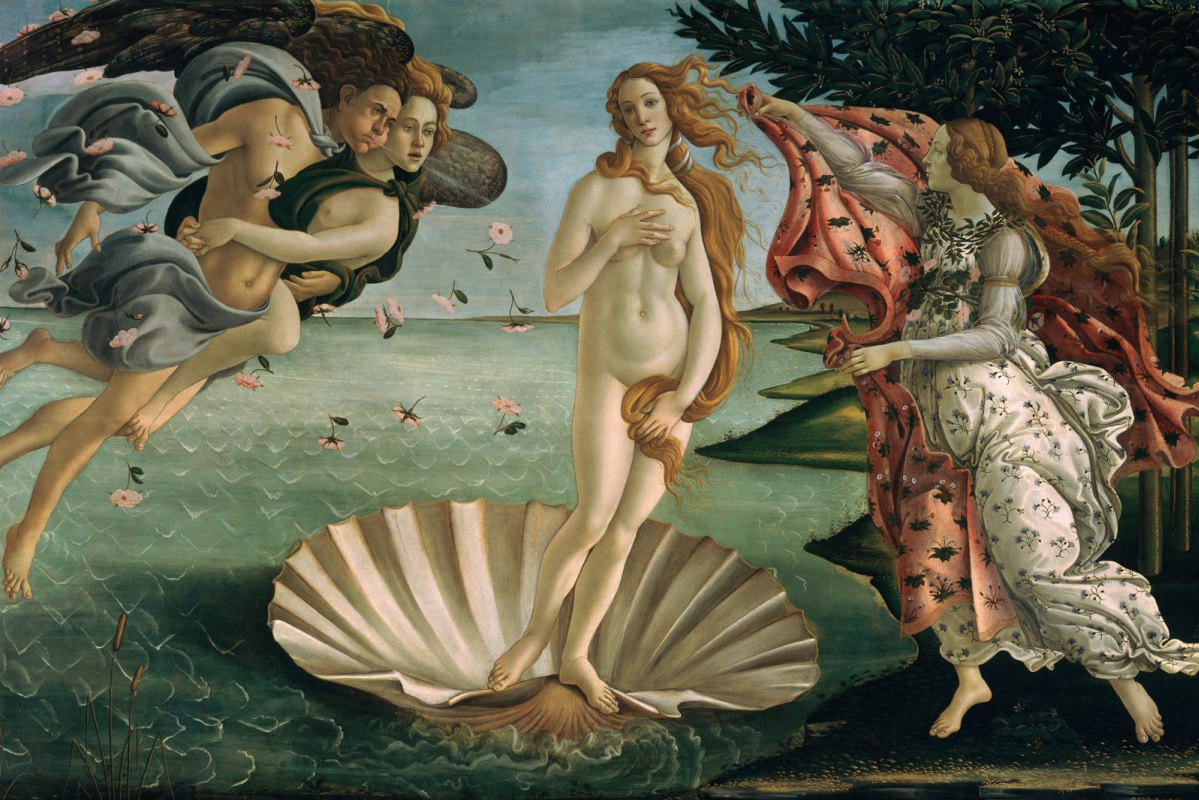log in
Enter site
Login to use Arthive functionality to the maximum
Birth Of Venus
Sandro Botticelli • Painting, 1486, 172.5×278.5 cm
Description of the artwork «Birth Of Venus»
The Renaissance gave mankind many masterpieces, among which the works of Botticelli take pride of place. The works by the great Florentine invariably attract the attention of visitors to the Uffizi Gallery, striking the audience with their grace and beauty of the captured images, magnificent rhythm and subtle play of shades.
“The Birth of Venus” by Sandro Botticelli was painted, as most historians believe, for Lorenzo Medici, a cousin of the Duke of Florence. Just like another work by Botticelli, “Spring”, the painting was kept in the Villa Castello owned by the Medici in 1486. The model for the central figure of the masterpiece is considered to be Simonetta Vespucci, the Incomparable and Beautiful Simonetta, who was the first beauty of Florence. This girl, who conquered the hearts of many men in her short life, according to the testimony of her contemporaries, possessed outstanding beauty, charm and meek disposition.
It is not surprising that it is she who is depicted in Botticelli’s “The Birth of Venus” painting, the main character of which must be the beautiful goddess of love. The feelings of the great painter for Simonetta are not known for certain, but her features are recognizable in the appearance of the heroines of other artist’s works, painted after Vespucci’s death.
In the Renaissance, for the first time in art, the beauty of the surrounding world comes to the fore, as opposed to asceticism and the religious background of the works of the Middle Ages. It was especially important for the artist to show the relationship between spiritual and physical beauty: Botticelli’s “The Birth of Venus” demonstrates the successful achievement of this goal.
In the centre of the plot, there is the figure of the beautiful ancient goddess born of sea foam. She floats on the waves in a shell, impelled by Zephyr, the west wind. It is interesting that the Zephyr’s dominance in the Mediterranean Sea begins in spring, which means that the birth of Venus fell on this period. On the shore, Venus is preparing to meet Thallo, the Hora of Spring, who holds a purple cloak in her hands to wrap up the newborn goddess.
The heroine’s delicate face bears great resemblance to the faces of the Madonnas, and her posture and body outlines resemble those of ancient Greek sculptures. This is how the great painter emphasized the relationship between antiquity and Christianity. Among the artists of the Renaissance, naked Venus did not symbolize sensuality or earthly pleasures at all, but heavenly love, chastity and purity, which were considered the highest virtues.
In “The Birth of Venus” painting by Sandro Botticelli, every detail is full of special meaning. The use of multiple symbols, religious iconography and the absolute composition harmony as a whole make the work by the outstanding Florentine a real masterpiece for all times, the study and deciphering of which has not yet been completed.
“The Birth of Venus” by Sandro Botticelli was painted, as most historians believe, for Lorenzo Medici, a cousin of the Duke of Florence. Just like another work by Botticelli, “Spring”, the painting was kept in the Villa Castello owned by the Medici in 1486. The model for the central figure of the masterpiece is considered to be Simonetta Vespucci, the Incomparable and Beautiful Simonetta, who was the first beauty of Florence. This girl, who conquered the hearts of many men in her short life, according to the testimony of her contemporaries, possessed outstanding beauty, charm and meek disposition.
It is not surprising that it is she who is depicted in Botticelli’s “The Birth of Venus” painting, the main character of which must be the beautiful goddess of love. The feelings of the great painter for Simonetta are not known for certain, but her features are recognizable in the appearance of the heroines of other artist’s works, painted after Vespucci’s death.
Analysis and description
In the Renaissance, for the first time in art, the beauty of the surrounding world comes to the fore, as opposed to asceticism and the religious background of the works of the Middle Ages. It was especially important for the artist to show the relationship between spiritual and physical beauty: Botticelli’s “The Birth of Venus” demonstrates the successful achievement of this goal.
In the centre of the plot, there is the figure of the beautiful ancient goddess born of sea foam. She floats on the waves in a shell, impelled by Zephyr, the west wind. It is interesting that the Zephyr’s dominance in the Mediterranean Sea begins in spring, which means that the birth of Venus fell on this period. On the shore, Venus is preparing to meet Thallo, the Hora of Spring, who holds a purple cloak in her hands to wrap up the newborn goddess.
The heroine’s delicate face bears great resemblance to the faces of the Madonnas, and her posture and body outlines resemble those of ancient Greek sculptures. This is how the great painter emphasized the relationship between antiquity and Christianity. Among the artists of the Renaissance, naked Venus did not symbolize sensuality or earthly pleasures at all, but heavenly love, chastity and purity, which were considered the highest virtues.
In “The Birth of Venus” painting by Sandro Botticelli, every detail is full of special meaning. The use of multiple symbols, religious iconography and the absolute composition harmony as a whole make the work by the outstanding Florentine a real masterpiece for all times, the study and deciphering of which has not yet been completed.


